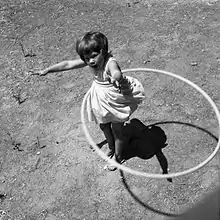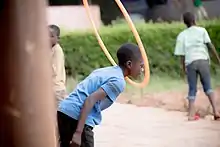Hula hoop
A hula hoop is a toy hoop that is twirled around the waist, limbs or neck. They have been used by children and adults since at least 500 BCE. The modern hula hoop was inspired by Australian bamboo hoops. The new plastic version was popularized in 1958 by the Wham-O toy company and became a fad. Hula hoops for children generally measure approximately 28 inches (71 cm) in diameter, while those for adults measure around 40 inches (1.0 m). Traditional materials for hoops include willow, rattan (a flexible and strong vine), grapevines and stiff grasses. Today, they are usually made of plastic tubing.[1]



Origins
Native American Hoop Dance is a form of storytelling dance incorporating hoops as props. These props are used to create both static and dynamic shapes, which represent various animals, symbols, and storytelling elements. The dance is generally performed by a solo dancer with multiple hoops.
Before it was known and recognized as the common colorful plastic toy (sometimes filled with water or sand), the traditional "hula hoop" was made of dried willow, rattan, grapevines, or stiff grasses. Though they have been in existence for thousands of years, it is often incorrectly believed that they were invented in the 1950s.[2]
Author Charles Panati records a "craze" with the usage of wooden and metal hoops in 14th-century England. He reports that doctors treated patients suffering from pain, dislocated backs, and even heart failure due to hooping.[3] Panati also says that the name "hula" came from the Hawaiian dance in the 18th century, due to the similar hip movements.[3]
Modern history
The hula hoop gained international popularity in the late 1950s, when a plastic version was successfully marketed by California's Wham-O toy company. In 1957 Joan Anderson brought back a bamboo "exercise hoop" from Australia, and came up with the name Hula Hoop at a dinner party. Her husband showed it to Arthur "Spud" Melin and they agreed on a gentleman's handshake that they would share in any profits (the company cut her out, and they got nothing).[4][5]
Richard Knerr and Arthur "Spud" Melin of Wham-O manufactured 42 in (1.1 m) dia. hoops from Marlex plastic. With giveaways, national marketing and retailing, a fad begin in July 1958:[6][7] twenty-five million plastic hoops were sold in less than four months, and sales reached more than 100 million units in two years.[1] Carlon Products Corporation was one of the first manufacturers of the hula hoop. During the 1950s, Carlon was producing more than 50,000 hula hoops per day. The hoop was inducted into the National Toy Hall of Fame at The Strong in Rochester, New York, in 1999.
The hula hoop craze swept the world, dying out in the 1980s except in China and Russia, where hula hooping and hoop manipulation were adopted by traditional circuses and rhythmic gymnasts.
Hooping as an activity

Many modern hoopers make their own hoops out of PVC piping, or polypropylene tubing (known as polypro). The polyethylene hoops, and especially the polyvinyl chloride hoops, are much larger and heavier than hoops of the 1950s. The size and the weight of the hoop affect the style of the hooper. Heavier, larger hoops are used for beginning dancers and easier tricks, while lighter, thinner tubing is used for quick hand tricks. These hoops may be covered in a fabric or plastic tape to create a visual image and distinguish between the hoop and dancer. Gaffer tape is used to line the inside of a hula hoop to add grip, or a bare hula hoop can be roughened by using sandpaper. Some use glow-in-the dark, patterned, or sparkling tape, and others are produced with clear tubing and are unfilled (child hoops are commonly filled with various materials). LED lighting has been added, allowing hoops to light up at the flick of a switch or a remote control. Programmable 'Smart Hoops' are available which provide a range of special effects and some can even be customized through an application on a mobile device.
Modern hooping has created a wide range of tricks. Hooping now includes many 'on body' moves and many 'off body' moves. A few examples are breaks, isolations, leg hooping, and double hooping.
Hooping is a popular fitness activity, with classes in many cities across the world.[8]
Fire hooping has been introduced, in which spokes are set into the outside of the hoop and tipped with kevlar wicks, which are soaked in fuel and ignited.
Collapsible hula hoops have been developed for easy transport and versatility.
World Records
See
In popular culture
- On September 6, 1958, singer Georgia Gibbs appeared on US TV's The Ed Sullivan Show to sing "The Hula Hoop Song". Her last US top-40 hit, it competed with four other songs created in the wake of the huge fad.[9]
- Hula hoops are mentioned in the 1958 Alvin and the Chipmunks song, "The Chipmunk Song (Christmas Don't Be Late)". Wayout Toys, under license to Emson, introduced the Alvin Hula Hoop Doll, which dances with his hula hoop and sings the song based on wanting his hula hoop.
- Joel and Ethan Coen's 1994 comedy film The Hudsucker Proxy tells a fictional story of the hula hoop's invention by a mail room clerk (Tim Robbins) who is installed as president of a manufacturing company as part of an intended business scheme.
- During the production of Pixar Animation Studios film WALL-E, Disney.com released a clip of Wall-E's first encounter with a hula hoop, swinging it across its neck.
- Artist Keller Williams released a song "Hula Hoop to the Loop", dedicated to the toy.
- The final season of M*A*S*H contains an episode titled "Who Knew?", in which Sergeant Klinger observes children playing with barrel rings, and fashions a hula hoop-like toy made of metal tubing. He then tries to get Major Winchester to fund their production, but fails.
- Hula Hooping Girl, a 2020 street art painting by Banksy in Nottingham, England, portrays a young girl hula-hooping with a bicycle tire.
References
- "Background, history, raw materials, design, and the manufacturing process of hula hoops". Madehow.com. Retrieved 2011-05-23.
- "Hula Hoop History". The Great Idea Finder. Retrieved 22 June 2012.
- Panati, Charles (1989). The Extraordinary Origins of Everyday Things. William Morrow Paperbacks / HarperCollins. ISBN 0062277081.
- Chris Riess; Amy Hill (March 25, 2019). "She Was Betrayed by a Gentleman's Handshake". The Atlantic.
- Hula Girl.
- Brymer, Chuck (2008). The nature of marketing: marketing to the swarm as well as the herd. Palgrave Macmillan. p. 22.
- Olson, James Stuart (2000). Historical dictionary of the 1950s. Greenwood Publishing Group. p. 136.
- Infinite Circles. "Beginners guide to learning hula hooping".
- Schoemer, Karen (2006). Great Pretenders: My Strange Love Affair with '50s Pop Music. Simon and Schuster. pp. 93–95.
Further reading
- Caughey, T. K. (February 1960), "Hula-Hoop: An Example of Heteroparametric Excitation", American Journal of Physics, 28 (2): 104–109, Bibcode:1960AmJPh..28..104C, doi:10.1119/1.1935069
- Seyranian, Alexander P.; Belyakov, Anton O. (July 2011), "How to twirl a hula hoop", American Journal of Physics, 79 (7): 712–715, arXiv:1101.0072, Bibcode:2011AmJPh..79..712S, doi:10.1119/1.3576177
External links
| Wikimedia Commons has media related to Hula hoops. |